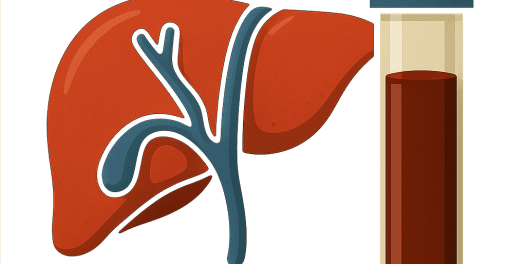Prealbumin levels: your complete guide to understanding your blood test results
When you look at a blood test report, the technical terms and numbers can be confusing. This situation often becomes more stressful when a value is flagged as abnormal. If the term “prealbumin” appears on your report with a result outside the normal range, you will naturally want to understand its meaning for your health. This article offers a clear explanation of this marker. It provides the information you need to approach the next steps with your physician calmly.
What is prealbumin?
Prealbumin, also known by its scientific name transthyretin, is a protein made primarily by the liver. It plays an important role in your body. This substance circulates in your bloodstream and carries out several vital tasks.
Biological origin and function
Your liver produces prealbumin daily and releases it into the blood. You can think of it as a delivery service for essential molecules your body needs to function correctly. Specifically, it transports two key components:
- Thyroid hormones, particularly thyroxine (T4), which are crucial for regulating your metabolism.
- Retinol, the active form of vitamin A, which is essential for healthy vision and immune system function.
A sensitive indicator of nutritional status
Transthyretin has a relatively short half-life of about two to three days. This means your body replaces it very frequently. Consequently, this feature makes it a highly sensitive indicator of your recent nutritional status. Like a barometer, it accurately reflects your protein intake over the last few days. This characteristic distinguishes it from other proteins, such as albumin, which remain in the bloodstream much longer.
If your dietary protein intake is insufficient, or if your body cannot use protein properly, the prealbumin level in your blood decreases quickly. Conversely, a balanced diet with enough protein helps maintain this marker at a healthy level.
Why is the prealbumin level measured?
Measuring prealbumin with a simple blood test serves several important medical purposes. Primarily, it helps assess a person’s overall nutritional status. The test can detect protein malnutrition, sometimes even before clear symptoms appear. For hospitalized patients, monitoring this marker helps evaluate the effectiveness of nutritional support.
Additionally, since the liver is the main source of this protein, its level can offer clues about liver function. An assessment of transthyretin can also help gauge the severity of certain chronic diseases. Doctors often consider this protein a “sentinel nutritional marker” because changes can provide an early warning. This enables timely management before more serious complications develop.
The importance of understanding prealbumin
Although prealbumin is just one of many parameters in a blood panel, it is closely linked to several key body systems. Therefore, its concentration in the blood significantly reflects and influences your overall health.
How prealbumin connects to overall health
When the level of this protein drops, it can trigger a cascade of effects. Research shows links between low transthyretin levels and several health issues. These include slower wound healing, a weaker immune response, and a more difficult recovery after surgery. These findings highlight the marker’s importance as an indicator of the body’s ability to handle major stressors.
Scientific advances in its role
Knowledge about prealbumin’s role has evolved. First discovered in the 1940s, it was initially thought to be a precursor to albumin. Scientists no longer support this theory. Later, in the 1970s, its function in transporting thyroid hormones was identified. By the 1980s, its value for assessing nutritional status was recognized.
More recently, scientific advances have revealed another aspect of this blood component. It appears to play a role in the body’s acute inflammatory response. In fact, its levels tend to drop during significant inflammation. This feature can complicate interpretation for people with both malnutrition and inflammatory conditions.
Long-term consequences of low prealbumin
If a low transthyretin level persists without proper care, the body can enter a state of nutritional decline. This may lead to serious consequences. Potential issues include loss of muscle mass, a weakened immune system, delayed healing, and an increased risk of pressure ulcers for bedridden individuals.
Moreover, chronic diseases may worsen. In vulnerable patients, this can lead to longer hospital stays and a higher risk of mortality. Therefore, regular measurement of this protein can help identify at-risk patients earlier and prompt effective nutritional interventions.
How to read and understand your test results
Knowing how to interpret your results gives you an advantage in managing your health. Here are some keys to better understanding your prealbumin level.
Decoding your lab report
On your lab report, transthyretin is usually listed under “Proteins” or “Nutritional Markers.” The result typically appears like this:
- Prealbumin (or Transthyretin): [Your Value] mg/L (or mg/dL)
- Reference range: [Laboratory Reference Interval]
Labs often use visual cues to highlight out-of-range results. For example, an abnormal value might be in red or bold. Sometimes, an arrow (↑ or ↓) indicates whether your value is above or below normal.
Typical reference values for prealbumin
Reference ranges for prealbumin can vary slightly between laboratories. However, they generally fall within these intervals:
- Adults: 200–400 mg/L (or 20–40 mg/dL)
- Children: 170–360 mg/L (or 17–36 mg/dL)
- Newborns: 100–240 mg/L (or 10–24 mg/dL)
It is crucial to check the unit used by your laboratory (mg/L or mg/dL). A mix-up in units could lead to a misinterpretation of your results.
A mini-checklist for your results
When you receive your test results, here are a few simple steps for an initial review:
- Compare your value to the lab’s reference range.
- Note how far your value is from the normal range.
- If you have previous tests, compare the results to see the trend.
- Recall the testing conditions, such as whether you were fasting.
- List your current medications, as some can influence protein levels.
- Consider any recent symptoms or dietary changes.
A prealbumin test performed while fasting can provide more standardized results. However, this marker is less affected by recent meals than some other blood parameters.
Conditions associated with transthyretin variations
Changes in prealbumin levels can signal various medical issues. Understanding these associations helps you interpret your results and anticipate what your doctor may do next.
Understanding a low prealbumin level
A low prealbumin level (typically below 200 mg/L) is the most common abnormality and can have several causes.
Nutritional causes of low prealbumin
Nutritional issues are the most frequent reason. These include:
- Protein-energy malnutrition from an insufficient intake of both protein and calories.
- Prolonged fasting or very restrictive diets.
- Anorexia nervosa.
- Intestinal malabsorption problems, such as celiac disease or Crohn’s disease.
Inflammatory causes
Inflammatory states can also lower this protein. Examples are:
- Acute or chronic infections.
- Significant trauma or recent surgery.
- Active autoimmune diseases.
- Certain cancers.
In these cases, inflammation alters the liver’s production of transthyretin, causing a temporary drop that may not reflect the true nutritional status.
Hepatic and other causes
Since the liver produces prealbumin, any disease affecting it can reduce synthesis, including cirrhosis or hepatitis. In other situations, a low level results from excessive protein loss from the body, such as with certain kidney diseases or extensive burns.
Identifying causes of a high prealbumin level
An elevated prealbumin level (usually above 400 mg/L) is less common but also requires investigation. Potential factors include:
- Use of high-dose corticosteroid medications.
- Certain conditions like Hodgkin’s disease.
- Chronic kidney failure, as the kidneys help clear transthyretin.
- Dehydration, which can concentrate proteins in the blood.
Further tests for abnormal prealbumin
If your result is abnormal, your doctor may order additional exams to clarify the diagnosis. For a low level, this might include a C-reactive protein (CRP) test to check for inflammation and a comprehensive liver panel. For a high level, an assessment of kidney function is common.
Practical tips if your prealbumin is abnormal
An abnormal result naturally raises questions. Here is a practical approach for managing the situation.
What to do if your prealbumin is low
A low prealbumin level deserves close attention.
- Consult your doctor: Schedule a visit for a thorough evaluation.
- Track your diet: A one-week food diary can be very useful.
- Note your symptoms: Record any unusual fatigue, recent weight loss, or digestive issues.
- Gather past results: This allows your doctor to assess any trends over time.
If your doctor confirms a nutritional cause, some dietary adjustments may help. Focus on increasing high-quality protein from sources like eggs, dairy, meat, fish, and legumes. Eating smaller, more frequent meals can also be beneficial.
What to do if your prealbumin is high
A high prealbumin level requires a different approach.
- Check your hydration: Dehydration can artificially increase protein concentrations.
- Discuss medications with your doctor: Some treatments can raise transthyretin levels.
- Evaluate kidney function: Your doctor will likely want to check how well your kidneys are working.
Medical follow-up timeline
Appropriate monitoring depends on your specific level and the underlying cause. For a slightly low level, nutritional changes followed by a retest in a few weeks is common. A very low level requires a more prompt medical consult and investigation. For a high level, follow-up will be adjusted to the identified cause, such as kidney issues.
Prealbumin frequently asked questions
Here are answers to common questions about this marker.
Is fasting required for a prealbumin test?
Prealbumin levels are not significantly influenced by a recent meal. While fasting is not technically required, it is often recommended to standardize testing conditions, especially if other tests that require fasting are drawn at the same time.
What is the difference between albumin and prealbumin?
Both are proteins that indicate nutritional status, but they have different half-lives. Albumin’s half-life is about 20 days, reflecting nutrition over several weeks. In contrast, prealbumin’s half-life is only two to three days. This makes it a much more sensitive marker for detecting recent changes in nutritional status.
Do certain medications affect prealbumin levels?
Yes, several medications can impact prealbumin. Corticosteroids tend to increase its level, while estrogens may lower it. It is important to inform your physician about all medications you are taking so they can interpret your results correctly.
Can prealbumin predict hospital outcomes?
Yes, numerous studies show that the prealbumin level at hospital admission is an important predictor of outcomes. For example, a very low level is linked to a higher risk of complications and longer hospital stays, especially in older adults.
Why is my prealbumin low despite adequate nutrition?
This can seem paradoxical. One common reason is underlying, or “subclinical,” inflammation, which suppresses the liver’s production of this protein. Another possibility is a malabsorption issue, where your body isn’t absorbing the protein you eat. In these cases, further medical investigation is necessary.
Conclusion
Prealbumin is a valuable biomarker that offers early and sensitive insight into your nutritional status. Understanding it gives you an extra tool for proactively managing your health.
Key impacts of prealbumin
- It acts as an “early alert system” for malnutrition.
- Its short half-life makes it excellent for monitoring nutritional therapies.
- Interpretation must always consider the full clinical context, especially inflammation.
- Regular monitoring, when indicated, helps prevent serious complications.
Additional resources
For more information about this blood marker, here’s a reliable resource:
Don’t wait any longer to take control of understanding your blood tests. Understand your laboratory analysis results in minutes with our aidiagme.com platform; your health deserves this special attention!
Decode other markers
You may also like

Total proteins blood test: Understanding and interpreting your results

Gamma-glutamyl transferase (GGT): A complete guide to this liver enzyme
